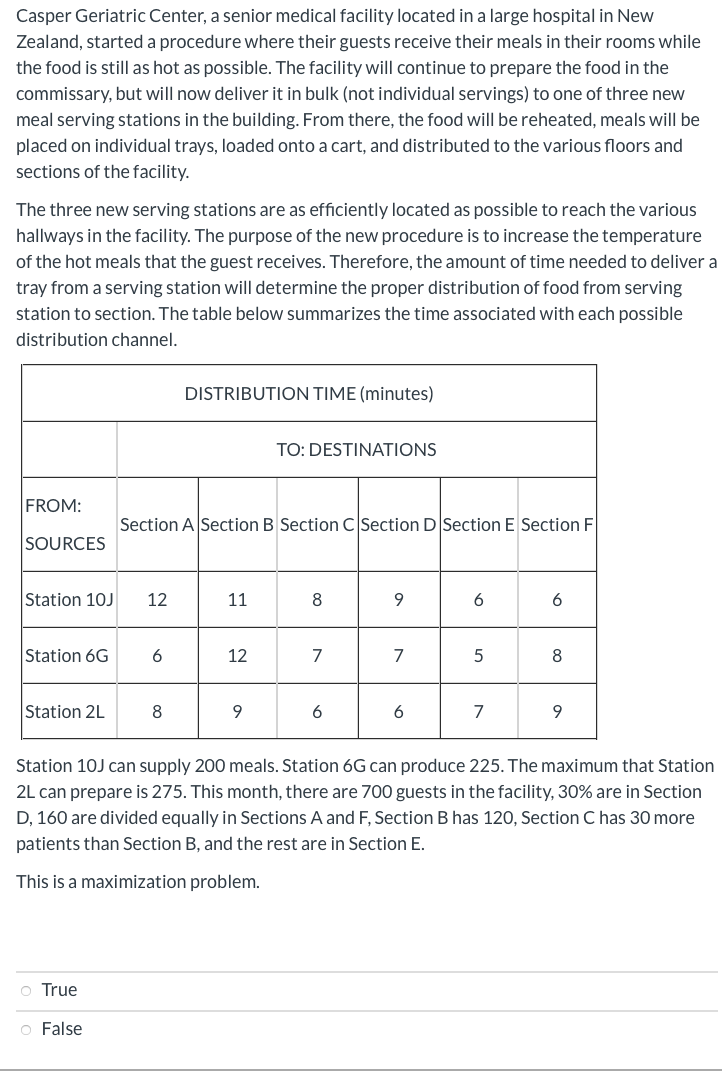Casper Geriatric Center, a senior medical facility located in a large hospital in New Zealand, started a procedure where their guests receive their meals in their rooms while the food is still as hot as possible. The facility will continue to prepare the food in the commissary, but will now deliver it in bulk (not individual servings) to one of three new meal serving stations in the building. From there, the food will be reheated, meals will be placed on individual trays, loaded onto a cart, and distributed to the various floors and sections of the facility. The three new serving stations are as efficiently located as possible to reach the various hallways in the facility. The purpose of the new procedure is to increase the temperature of the hot meals that the guest receives. Therefore, the amount of time needed to deliver a tray from a serving station will determine the proper distribution of food from serving station to section. The table below summarizes the time associated with each possible distribution channel. DISTRIBUTION TIME (minutes) TO: DESTINATIONS FROM: Section A Section B Section C Section D Section E Section F SOURCES Station 10J 12 11 8 9 6 Station 6G 6 12 7 8 Station 2L 7 Station 10J can supply 200 meals. Station 6G can produce 225. The maximum that Station 2L can prepare is 275. This month, there are 700 guests in the facility, 30% are in Section D, 160 are divided equally in Sections A and F, Section B has 120, Section C has 30 more patients than Section B, and the rest are in Section E. This is a maximization problem. o True o False 6
Casper Geriatric Center, a senior medical facility located in a large hospital in New Zealand, started a procedure where their guests receive their meals in their rooms while the food is still as hot as possible. The facility will continue to prepare the food in the commissary, but will now deliver it in bulk (not individual servings) to one of three new meal serving stations in the building. From there, the food will be reheated, meals will be placed on individual trays, loaded onto a cart, and distributed to the various floors and sections of the facility. The three new serving stations are as efficiently located as possible to reach the various hallways in the facility. The purpose of the new procedure is to increase the temperature of the hot meals that the guest receives. Therefore, the amount of time needed to deliver a tray from a serving station will determine the proper distribution of food from serving station to section. The table below summarizes the time associated with each possible distribution channel. DISTRIBUTION TIME (minutes) TO: DESTINATIONS FROM: Section A Section B Section C Section D Section E Section F SOURCES Station 10J 12 11 8 9 6 Station 6G 6 12 7 8 Station 2L 7 Station 10J can supply 200 meals. Station 6G can produce 225. The maximum that Station 2L can prepare is 275. This month, there are 700 guests in the facility, 30% are in Section D, 160 are divided equally in Sections A and F, Section B has 120, Section C has 30 more patients than Section B, and the rest are in Section E. This is a maximization problem. o True o False 6
Linear Algebra: A Modern Introduction
4th Edition
ISBN:9781285463247
Author:David Poole
Publisher:David Poole
Chapter2: Systems Of Linear Equations
Section2.4: Applications
Problem 28EQ
Related questions
Question

Transcribed Image Text:Casper Geriatric Center, a senior medical facility located in a large hospital in New
Zealand, started a procedure where their guests receive their meals in their rooms while
the food is still as hot as possible. The facility will continue to prepare the food in the
commissary, but will now deliver it in bulk (not individual servings) to one of three new
meal serving stations in the building. From there, the food will be reheated, meals will be
placed on individual trays, loaded onto a cart, and distributed to the various floors and
sections of the facility.
The three new serving stations are as efficiently located as possible to reach the various
hallways in the facility. The purpose of the new procedure is to increase the temperature
of the hot meals that the guest receives. Therefore, the amount of time needed to deliver a
tray from a serving station will determine the proper distribution of food from serving
station to section. The table below summarizes the time associated with each possible
distribution channel.
DISTRIBUTION TIME (minutes)
TO: DESTINATIONS
FROM:
Section A Section B Section CSection D Section E Section F
SOURCES
Station 10J
12
11
8
9.
6
Station 6G
12
7
7
8
Station 2L
8
9.
6
7
9.
Station 10J can supply 200 meals. Station 6G can produce 225. The maximum that Station
2L can prepare is 275. This month, there are 700 guests in the facility, 30% are in Section
D, 160 are divided equally in Sections A and F, Section B has 120, Section C has 30 more
patients than Section B, and the rest are in Section E.
This is a maximization problem.
o True
o False
Expert Solution
This question has been solved!
Explore an expertly crafted, step-by-step solution for a thorough understanding of key concepts.
Step by step
Solved in 2 steps

Knowledge Booster
Learn more about
Need a deep-dive on the concept behind this application? Look no further. Learn more about this topic, advanced-math and related others by exploring similar questions and additional content below.Recommended textbooks for you

Linear Algebra: A Modern Introduction
Algebra
ISBN:
9781285463247
Author:
David Poole
Publisher:
Cengage Learning

Algebra for College Students
Algebra
ISBN:
9781285195780
Author:
Jerome E. Kaufmann, Karen L. Schwitters
Publisher:
Cengage Learning

Linear Algebra: A Modern Introduction
Algebra
ISBN:
9781285463247
Author:
David Poole
Publisher:
Cengage Learning

Algebra for College Students
Algebra
ISBN:
9781285195780
Author:
Jerome E. Kaufmann, Karen L. Schwitters
Publisher:
Cengage Learning